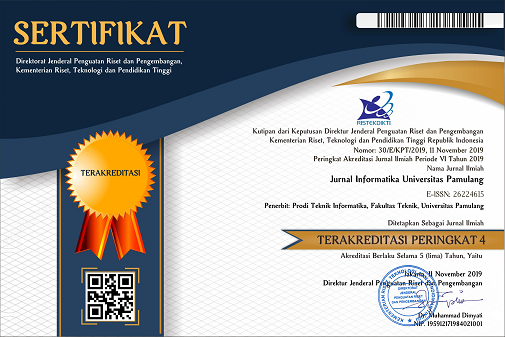Fuzzy Reasoning untuk Analisa Keterkaitan Hubungan Jurusan di Sekolah Menengah Atas dengan Kemampuan Programming Mahasiswa
DOI:
https://doi.org/10.32493/informatika.v6i3.8866Keywords:
Programming, Fuzzy, Reasoning, MamdaniAbstract
Programming is one of the skills which is very important today, especially in the Internet of Things (IoT) technology. Applications are the top layer of IoT, so the capability of application creation is most important. The basis for making applications is an algorithm related to logic, namely the ability to solve problems. Currently, students' logic and programming skills are still very lacking by a percentage of 10% - 15% per class for a total of 35 people. Secondary education background is a provision for students in the college process. And students' secondary education backgrounds vary, such as science, social studies, accounting, automotive, RPL, Multimedia, TKJ, etc. If the informatics study program wants to get graduates with good abilities, it is necessary to consider a suitable educational background. The above is the basis of this research, namely knowing the influence of high school students' majors on their programming abilities. The method for this problem uses Fuzzy Reasoning. This method can solve problems that are uncertain or fuzzy with an approach to existing problems or data. The stages of the method are input (crisp), fuzzification, inference, defuzzification, and output (crisp). The data to be used are majors and two grades from subjects related to logic according to majors. The algorithm that be used in the Fuzzy Method is Mamdani. The output of the defuzzification is the value level of the majors in the Hight Scholl or Vocational School. Those are the order of most suitable for the Informatics Engineering Study Program (IT Study Program). The values obtained are processed using fuzzy similarity to get the similarity value or case suitability. The application of the method in this study resulted in the suitability value of the high school / vocational majors with the informatics engineering study program of 51.97%. It means that the student background is not suitable for the informatics engineering study program. While the accuracy rate is 63.46%.
References
Abdiansah, A. (2013). Fuzzy Case-Based Reasoning: Implementasi Logika Fuzzy Pada Case-Based Reasoning. Jurnal Generic, 8(1), 169–180.
Atzori, L., Iera, A., & Morabito, G. (2010). The Internet of Things: A survey. Computer Networks, 54(15), 2787–2805. https://doi.org/10.1016/j.comnet.2010.05.010
Besari, A. R. A., Wobowo, I. K., Sukaridhoto, S., Setiawan, R., & Rizqullah, M. R. (2017). Preliminary design of mobile visual programming apps for Internet of Things applications based on Raspberry Pi 3 platform. Proceedings - International Electronics Symposium on Knowledge Creation and Intelligent Computing, IES-KCIC 2017, 2017-January, 50–54. https://doi.org/10.1109/KCIC.2017.8228460
Hasanuddi, R. S., Isnawati, Saputra, R. A., & Statiswaty. (2019). Sistem Kontrol dan Monitoring Hidroponik Secara Real Time Menggunakan Metode Fuzzy Inference System Model Tsukamoto. SemanTIK.
Irsan, M. Y., Kasau, M. I., & Simbolon, I. P. (2019). Penggunaan Fuzzy Logic & Metode Mamdani untuk Menghitung Pembelian, Penjualan dan Persediaan . JAAF (Journal of Applied Accounting and Finance) .
Izzah, A., & Widyastuti, R. (2016). Prediksi Kelulusan Mata Kuliah Menggunakan Hybrid Fuzzy Inference System. Register: Jurnal Ilmiah Teknologi Sistem Informasi, 2(2), 60. https://doi.org/10.26594/r.v2i2.548
Krishnamurthy, J., & Maheswaran, M. (2016). Programming frameworks for Internet of Things. In Internet of Things: Principles and Paradigms. https://doi.org/10.1016/B978-0-12-805395-9.00005-8
Mustafidah, H., & Aryanto, D. (2012). Sistem Inferensi Fuzzy untuk Memprediksi Prestasi Belajar Mahasiswa Berdasarkan Nilai Ujian Nasional, Tes Potensi Akademik, dan Motivasi Belajar. JUITA.
Santiari, P. L. (2016). Penggunaan Metode Fuzzy Dalam Penilaian Tingkat Kemampuan Non-Akademik Mahasiswa Melalui Satuan Kredit Kegiatan Mahasiswa. Jurnal Teknologi Informasi Dan Ilmu Komputer, 3(4), 253. https://doi.org/10.25126/jtiik.201634182
Subbotin, I. Y., & Voskoglou, M. G. (2015). Applications of fuzzy logic to systems’ modelling. Research Methods: Concepts, Methodologies, Tools, and Applications, (March 2014), 1277–1291. https://doi.org/10.4018/978-1-4666-7456-1ch055
Sutoyo, M. N., & Sumpala, A. T. (2016). Penerapan Fuzzy C-Means untuk Deteksi Dini Kemampuan Penalaran Matematis. Scientific Journal of Informatics, 2(2), 129. https://doi.org/10.15294/sji.v2i2.5080
Zafar, S., & Farooq, M. S. (2019). A graphical methodology to promote programming language concepts in novice. 3rd International Conference on Innovative Computing, ICIC 2019, (Icic). https://doi.org/10.1109/ICIC48496.2019.8966727
Downloads
Published
Issue
Section
License
Authors who publish with this journal agree to the following terms:
- Authors retain copyright and grant the journal right of first publication with the work simultaneously licensed under a Creative Commons Attribution-NonCommercial 4.0 International (CC BY-NC 4.0) that allows others to share the work with an acknowledgement of the work's authorship and initial publication in this journal.
- Authors are able to enter into separate, additional contractual arrangements for the non-exclusive distribution of the journal's published version of the work (e.g., post it to an institutional repository or publish it in a book), with an acknowledgement of its initial publication in this journal.
- Authors are permitted and encouraged to post their work online (e.g., in institutional repositories or on their website) prior to and during the submission process, as it can lead to productive exchanges, as well as earlier and greater citation of published work (See The Effect of Open Access).
Jurnal Informatika Universitas Pamulang have CC-BY-NC or an equivalent license as the optimal license for the publication, distribution, use, and reuse of scholarly work.
In developing strategy and setting priorities, Jurnal Informatika Universitas Pamulang recognize that free access is better than priced access, libre access is better than free access, and libre under CC-BY-NC or the equivalent is better than libre under more restrictive open licenses. We should achieve what we can when we can. We should not delay achieving free in order to achieve libre, and we should not stop with free when we can achieve libre.
Jurnal Informatika Universitas Pamulang is licensed under a Creative Commons Attribution-NonCommercial 4.0 International (CC BY-NC 4.0)
YOU ARE FREE TO:
- Share : copy and redistribute the material in any medium or format
- Adapt : remix, transform, and build upon the material for any purpose, even commercially.
- The licensor cannot revoke these freedoms as long as you follow the license terms





